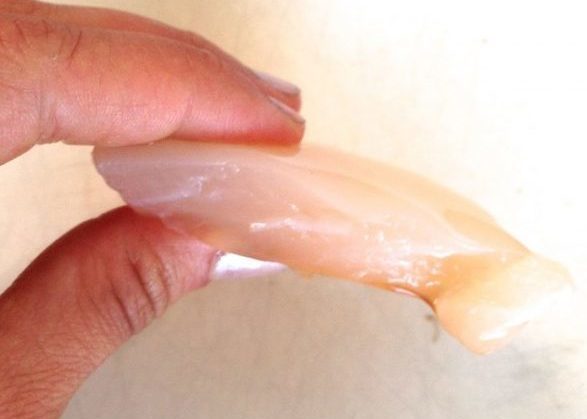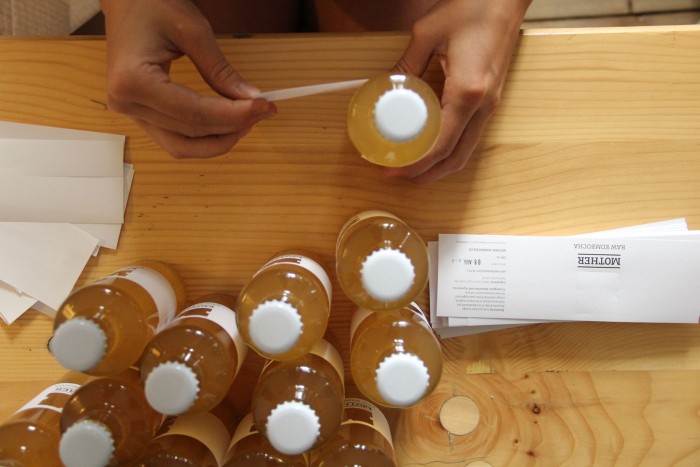First off, what is kombucha and why am I hearing this word so often? Kombu… that’s some kind of sea-weed and cha…means tea in Japanese right? Well technically yes, however kombucha is in no way a sea-weed-tea, but rather a sparkling-fermented-tea drink. Sweetened most commonly with sugar, and steeped in black tea.
Easy enough, but fermented?, you may ask. Yes, Fermented typically for 7-14 days. This is what gives kombucha its unique sour taste and often there is a light carbonation. However, not to forget all of the health claims it holds.
Kombucha is fermented with a combined culture of special bacteria and yeasts that are actually useful for our wellbeing. Have you ever heard that humans are only 10% actually human, and the rest of the 90% of our cells are comprised of different bacteria? If not, then know that it’s true! Good.
Now that we know we have lots of bacteria in-on-and-around us, why would it be helpful to drink a sweet-n-sour fermented tea drink? The answer is simpler then one may think. Consuming those good and living bacteria – also known as probiotics – help keep up the bacterial diversity inside ourselves which, in turn, keeps us healthy by crowding out the bad bacteria’s that want to get in and make us sick, or tired, even allergic.
Here is a piece of the SCOBY – Symbiotic Colony Of Bacteria and Yeast! Looks fleshy!
But where do those living-biotics come from? From the kombucha-Mother of course. Everyone has a mother – and so do cultures of bacteria and yeasts like our beloved kombucha!
This mothers appetite is the sugar in the tea solution, and ‘she’ digests them to burp out carbon dioxide, lacto-bacillus and all sorts of other happy-for-our body vitamins… B1, B2, niacin and riboflavin to name a few.
Some parts of the world refer to this drink ‘living-tea’ or ‘tea-of-life’ – not only from the living-physical disk that floats on top of the fermenting tea, but the life that remains in the tea as you drink it.
No, don’t worry – you wont grow one of these strange disks in your stomach, although the prospect seems somewhat intriguing. With these probiotics helping you out, it’s possible to notice better digestion! Hurrah!
Also, eating or drinking living foods such as sauerkraut, yogurt or kombucha which contain many antioxidants, our bodies start a detox – meaning toxins are being pushed out of our body – Ahh where?! Not to fret. The first exit is simply through our skin, and this can be one of the reasons one might get rosy cheeks after drinking lots of red wine. With good digestion and detoxification comes also a clearer mind, and furthermore energy!
Kombucha is often brewed with a black tea, types like Darjeeling, or Assam, but further experiments can be done with green tea, red bush tea, and an assortment of other teas to make variations of flavor and colour. One can find dozens of brands of commercial kombucha on the shelves, especially in north American markets.
However not all of these kombucha brands are as ‘healthy’ or ‘living’ as it may seem. Being a consumer, we can become aware of sugar content, expiration date, if pasteurization occurred to kill all the life in the bottle etc – and thus become more conscious of how alive a well produced, local kombucha looks like.
<————————————
Click here to Watch HOW TO make Kombucha!<————————————-







can i use my acv scoby to turn it into a tea scoby?
you can definitely try this if you are enjoying the ACV taste. however there is a slightly different composition of bacteria and yeast in a kombucha SCOBY compared to an ACV SCOBY. kombucha has gluconic acid, acetic acid, and fructose whereas the vinegar SCOBY is lacking the glyconic acid component. perhaps its possible to slowly nurture your ACV SCOBY to have this, as you can nurture a kombucha SCOBY to be Jun… but i would suggest to get a separate kombucha SCOBY to do the job in the regular steps, but i never say never to experimenting!
thanks for the information
anytime! 😀 happy to share
useful information
I’ve been brewing kombucha for a couple of years.
Since moving house the scoby no longer grows or renews at the previous rate.
The new house is double glazed so temperature remains cooler.
Before moving, I was brewing kombucha in around 8 – 10 days and I would have a completely new scoby every batch (I brew in a big jar so scoby a bit bigger than a side plate) and I would peel the new scoby off and discard the old one every batch. Since moving house I’ve made about 8? batches of kombucha. The scoby doesn’t seem to grow much and I havnt thrown any of the scoby out since moving. The kombucha tastes ok, and there is plenty of activity- bubbling etc but I’m a bit concerned about what we are actually drinking may not be the right bacteria?
The weather is warmer now and I have found the warmest place to keep the brew is in the spare room with the window left open.
I’ve just bottled a brew yesterday. It only took 8 days, some of the previous batches have taken up to 3 weeks (we have had a heat wave) I think the scoby mass increased but there isn’t much of the lovely rubbery scoby it’s more the gunky stuff they use to float around the edges.
Do you think I should buy a new scoby and start again
Louisa
Hey Louisa,
i often allow my SCOBY to get big and fat and let it stay in the brew for at least 5 batches. then when its getting old, i toss the old one and usually make sure to clean up the stringy yeast bits for a clearer taste. i would suggest letting your SCOBY’s stay in the jar a bit longer to get nice and strong. as long as there is a SCOBY (symbiotic colony of bacteria and yeast) on top, you can be sure that you have a good combination of bacteria and yeast that are keeping the nasty ones away. as soon as any funky fuzyy molds or colours appear, then you would want to worry. environments always change the taste and activity of kombucha. even from one side of a city to another. so i think its just about getting reaquainted with your kombucha SCOBY in its new environment 🙂
Hey Alexis,
I have a candida overgrowth, wich I can sort of manage with my diet of no sugar, absolutely no beer, almost no yeast-products (some bread) and some other adjustments.
I am afraid that drinking kambucha will give the candida a boodt to grow again… can you please give me your advise?
Thanks a lot!
Patricia
hi Patricia, i would avoid things like kombucha which have a high sugar / candida count depending on how its fermented.